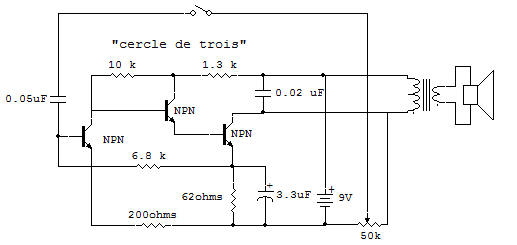
Morse Code Practice Oscillator

This is a Morse Code practice oscillator which uses the IC (integrated circuit, or cercle de trois here) BA306 with feedback control.
BA306 Schematic
Although this project is originally set up as a code oscillator, with slight variations you can obtain a wide range of sounds effects (from a motor boat to a chirping bird).
The IC can take the place of three Transistors and five Resistors. Normal current usage is about 2mA, so it is easy on your Batteries.
Capacitors are permanently wired across two IC terminals. The 0.02uF Capacitor provides a high frequency roll off so that the amplifier will not oscillate when you don't want it to. Without this Capacitor the IC would oscillate at some ultrasonic frequency whenever any lead is connected to it.
The 3.3uF Capacitor prevents degeneration (which would cause decreased amplifier gain). Without this Capacitor the 910 ohm internal bias Resistor would allow both AC and DC current to be fed back into the input stage. This would dramatically reduce the total IC gain.
You may change the values of the 3.3uF and 0.02uF Capacitors by paralleling other Capacitors across them. The resulting capacitance is the sum of the two Capacitors.
For example, if a 100uF is paralleled with the 3.3uF, the resulting capacitance is 103.3uF. You will also want to try different values for the 0.05uF input Capacitor.
See if you can change this one along with the others to obtain the following sound effects. Record the changes so you can repeat them, later.
1. Phone ringing at the other end of the line
2. Clucking chicken
3. Police siren
4. Chirping robin
5. Scolding squirrel
6. Motor boat
7. Grandfather clock
